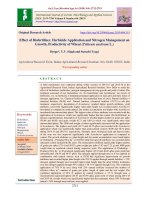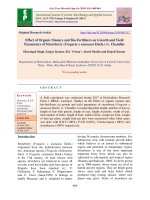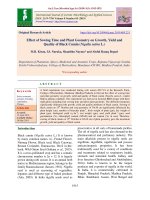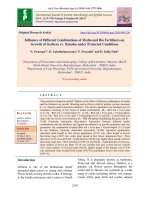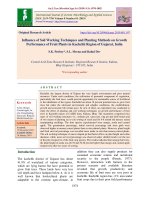Effect of free range-area and feed restriction on growth performance of hungarian landrace guinea fowl
Bạn đang xem bản rút gọn của tài liệu. Xem và tải ngay bản đầy đủ của tài liệu tại đây (175.52 KB, 6 trang )
TẠP CHÍ KHOA HỌC TRƯỜNG ĐẠI HỌC TRÀ VINH, SỐ 34, THÁNG 6 NĂM 2019
DOI: 10.35382/18594816.1.34.2019.189
EFFECT OF FREE-RANGE AREA AND FEED RESTRICTION
ON GROWTH PERFORMANCE OF HUNGARIAN LANDRACE
GUINEA FOWL
Thieu Ngoc Lan Phuong1 , Timea Roza Ferencz2 , Katalin Kovacsne Gaal3 , Ildiko Barta4 ,
Kisne Do Thi Dong Xuan5 , Andrea Emodi6 , Szalay István7
(1378.52 ± 43.68 g) with relatively low feed
conversion ratio (3.82 ± 0.14 kg feed per kg
body weight gain) when compared with other
experimental groups at the age of 14 weeks.
The lowest body weight and feed conversion
ratio was observed in groups with 15 m2 freerange area per bird and 70% feed restriction
(1245.93 ± 38.64 g and 3.52 ± 0.12 kg feed
per kg body weight gain), while the highest
feed conversion ratio was detected in groups
fed ad libitum and kept closed, without a free
range area (4.34 ± 0.06 kg feed per kg body
weight gain).
Keywords: conservation, free-range, and
local guinea fowl.
Abstract – Hungarian Landrace Guinea
Fowls are famous for their excellent meat
quality produced by traditional free-range
farming. The study aimed to identify the
optimal size of a free-range area for keeping Hungarian Landrace Guinea Fowl, and
to examine its effect in combination with
quantitative feed restriction on growth performance, 486 birds were randomly distributed
into 18 cages. Free-range areas of different
sizes (either 50 m2 or 15 m2 per bird, or
without a running area) were provided from
6 weeks of age, and from 9 to 14 weeks,
feed restriction at varying levels of 90%,
80%, 70% or ad libitum feeding was also
applied. Body weight, body weight gain and
feed conversion ratios were recorded every
two weeks. Results showed that differing freerange area sizes and feed restriction had
a substantial effect on the body weight of
Hungarian Landrace Guinea Fowl, which
was evident by the age of 10 weeks and
continued until 14 weeks, where feed restriction negatively affected guinea fowl growth
in free-range keeping. Guinea fowl provided
with 15 m2 of free-range area per bird and
fed ad libitum had the highest body weight
I. INTRODUCTION
There is evidence that guinea fowl had
been introduced into the Carpathian Basin
several centuries earlier than the first reports
of the breeding of this animal appeared, and
was kept as a pet around manor houses or
monasteries from the Middle Ages [1], [2],
thereafter a long adaptation process resulted
in local landrace varieties. However, with
the expansion of the poultry industry, local
landraces have begun to disappear gradually
from rural areas. The collection of local
guinea fowl individuals from various rural
regions in Hungary for conservation purposes
was initiated in the early 1990’s. The breed
was officially registered under the name of
Hungarian Landrace Guinea Fowl (HLGF)
in 2004 by the Association of Hungarian
Small Animal Breeders for Gene Conservation (MGE). Since then, unselected stocks of
HLGF have been kept as part of in vivo gene
bank at the Research Centre for Farm Animal
Gene Conservation (HáGK) and Hortobagy
1,4,6
Research Centre for Farm Animal Gene Conservation (HáGK), H-2100 G¨od¨oll˝o, Isaszegi út 200., Hungary;
Association for Hungarian Farm Animal Gene Conservation
(MGE), H-2100 G¨od¨oll˝o, Isaszegi út 208., Hungary
2,3
Szechenyi Istvan University, Faculty of Agricultural
and Food Sciences (SZE-MEK), Var 2, H-9200, Mosonmagyaróvár, Hungary; Association for Hungarian Farm Animal
Gene Conservation (MGE), H-2100 G¨od¨oll˝o, Isaszegi út
208., Hungary
5,7
Association for Hungarian Farm Animal Gene Conservation (MGE), H-2100 G¨od¨oll˝o, Isaszegi út 208., Hungary
Email:
Received date: 10th May 2019; Revised date: 04th June
2019; Accepted date: 30th July 2019
37
TẠP CHÍ KHOA HỌC TRƯỜNG ĐẠI HỌC TRÀ VINH, SỐ 34, THÁNG 6 NĂM 2019
National Park (HNP) [3]. Several studies
emphasize that local guinea fowl would be
one of the promising genetic resources for
evolving in low input systems which can be
seen from the popularity of keeping guinea
fowl in underprivileged regions of Africa
[4], [5], Central Europe an countries [6]–[8]
as well as in Southeast Asia [9]. Scientists
consider guinea fowl as a reliable contributor
to the livelihood of rural people [10], [11],
and therefore, has the potential for reducing
poverty [12]. Because of this, studies on
the improvement of guinea fowl productivity,
as well as investigation into the effects of
genetic potential on productive and reproductive traits of local varieties for future use in
various regions, are essential.
II.
NÔNG NGHIỆP - THỦY SẢN
of a free-range area for keeping HLGF using
traditional methods and examines the effect
of qualitative feed restriction on the growth
performance of HLGF.
III.
MATERIALS AND METHODS
A. Experimental design
This study took place at the HáGK in vivo
poultry gene bank farm in G¨od¨oll˝o, Hungary.
A base population of 486 birds were hatched
from the nucleus stock of the HLGF gene
bank. All chicks were marked with individual
wing bands, then at birth, males and females
were pooled together for investigation. In the
first 5 weeks, the birds were kept in an
enclosed area with a density of 40 birds per
m2 and fed ad libitum. From 6 weeks of
age, all 486 birds were moved to a house
for growers with free-range areas of different
sizes (either 50 m2 or 15 m2 per bird) or
without a running area, and were randomly
distributed into 18 cages (27 birds per cage,
9 birds per m2). From 9 to 14 weeks of age,
different feeding regimes (feed restriction at
the levels of 90%, 80%, 70% and ad libitum feeding) were applied. The experimental
design of the HLGF rearing system, and the
labels of treatments are shown in Table 1.
Quantitative feed restrictions were applied
through the control of the daily feed supply.
From 9 to 14 weeks of age, the amount
of feed given (FG) in the restricted feeding
regimes was calculated based on measured
feed intake (FI) of the ad libitum group from
the previous week.
Equations used for the calculation of FG
at 9 weeks of age were:
FG of 15R90 in ith week =90% × FI of
15Adl in jth week FG of 15R80 in ith week
=80% × FI of 15Adl in jth week FG of
15R70 in ith week =70% × FI of 15Adl in
jth week
Where: j = a previous week (j= 8, 9, 10,
11, 12 and 13); and i = j + 1 week (i= 9, 10,
11, 12, 13 and 14)
The feed that was supplied was the feed
prescribed by Szalay et al. [6] was given to all
groups. The survival rate, body weight (BW),
BACKGROUND
Hungarian poultry experts in the 20th
century, Zoltan Csukas (1935) and Balint
Baldy (1940), mentioned that excellent meat
quality, good adaptability, disease resistance,
and low keeping costs made guinea fowl an
excellent poultry species - not only for local
consumption but also for foreign markets. To
ensure these superior traits are kept during
farming practices, there is emphasis placed
on the fact that guinea fowl should be kept
using traditional methods as a scavenging
bird around houses or large free-range farms
[13], [14]. These traditional methods were
characteristic for local guinea fowl raising
in Hungary before the expansion of the
poultry industry and can be considered as
‘traditional free-range farming’. Regarding
nutritional regimes, Molapo and Webb [15]
found that quantitative restriction of feeding
applied as part of the rearing system could
be advantageous in body weight gain of local
chickens, which can be applicable seeing that
guinea fowl chicks at growing stages have
the same nutritional behaviour as chickens,
thus restricted feeding may be useful for
improving their growth performance [16].
However the effect of restricted feeding on
production in guinea fowl remains uncertain.
This study aims to identify an optimal size
38
TẠP CHÍ KHOA HỌC TRƯỜNG ĐẠI HỌC TRÀ VINH, SỐ 34, THÁNG 6 NĂM 2019
NÔNG NGHIỆP - THỦY SẢN
Table 1: Experimental arrangement of Hungarian Landrace Guinea Fowl rearing systems from
6 to 8 and from 9 to 14 weeks of age
Label
Birds x cages
6-8 weeks of age
9-14 weeks of age
50Adl
27 × 3
50 m2 free-range area per bird ad libitum feeding
50 m2 free-range area per bird ad libitum feeding
00Adl
27 × 3
No free-range area per bird ad libitum feeding
No free-range area per bird ad libitum feeding
15Adl
27 × 3
15 m2 free-range area per bird ad libitum feeding
15 m2 free-range area per bird ad libitum feeding
15R90
27 × 3
15 m2 free-range area per bird ad libitum feeding
15 m2 free-range area per bird restricted feeding
at 90%
15R80
27 × 3
15 m2 free-range area per bird restricted feeding
15 m2 free-ranging area per bird ad libitum feeding
at 80%
15R70
27 × 3
15 m2 free-range area per bird restricted feeding
15 m2 free-ranging area per bird ad libitum feeding
at 70%
area and feeding regimes as they aged. Average BW measured on the hatching day and
at the end of the 5th week was 29 g and 287
g respectively. Following the application of
different sizes of free-range areas and feeding
regimes, the average BW and FCR recorded
at the ages of weeks 6, 8 and weeks 10, 12,
14 are shown in Tables 2 and 3. Figure
1 illustrates BWG of HLGF in the period
between 8 to 14 weeks of age. The results
of Levene’s test indicated that equality of
variances could be assumed. The size of the
free-range area did not affect BW, FCR of
HLGF between the 6th and 8th week. The
significant impact of free-range area size on
BW was found at the age of 10 weeks and
on FCR at the age of 10, 12 and 14 weeks
and it had a substantial effect on the BWG
of HLGF at all ages. While the effect of feed
restriction on BW and BWG was apparent, it
was hardly seen to affect FCR.
body weight gain (BWG) and feed conversion
ratio (FCR, kg feed per kg body weight gain)
of HLGF was recorded at birth, 5 weeks of
age and every two weeks from the 6th week.
Experimental birds were tested in compliance
with the national laws and regulations of
HáGK.
B. Data analysis
All statistical tests were performed by
SPSS software version 20 [17], mean and
standard deviation was estimated. Data was
subjected first to Levene’s test for homogeneity, then one-way ANOVA (for the 6th and 8th
week) and two-way ANOVA test (weeks 10,
12 and 14). Following ANOVA, a pairwise
comparison was conducted by Tukey test.
IV.
RESULTS AND DISCUSSION
This study showed that the survival rate of
guinea fowl kept in all investigated systems
was relatively high. From six to fourteen
weeks of age, the lowest recorded survival
rate was 96.3% with no significant difference
amongst groups. The average BW and FCR
of HLGF were comparable to the results
observed in studies of Blum et al. [18] and
Adjetey et al. [19]. HLGF seemed to become
more sensitive to the sizes of the free-range
The results showed that BW and BWG
of birds with feed restriction were significantly lower than birds fed ad libitum. The
higher rate of feed restriction was applied,
the lower BWG was recorded. From 8 to 14
weeks of age, the 15Adl experimental group
gained 634.07 ± 41.95 g and grew 1.47 ±
0.09% per day. This result was comparable
to that of 15R90 but significantly higher than
39
TẠP CHÍ KHOA HỌC TRƯỜNG ĐẠI HỌC TRÀ VINH, SỐ 34, THÁNG 6 NĂM 2019
NÔNG NGHIỆP - THỦY SẢN
Table 2: Average body weight (BW, g) and feed conversion ratio (FCR, kg feed per kg body
weight gain) of Hungarian Landrace Guinea Fowl, kept with different free-range area sizes,
and recorded on weeks 6 and 8.
50m2 per bird
15m2 per bird
No free-range area
Sig.
50Adl
15Adl
15R90
15R80
15R70
00Adl
Mean ± SD
Mean ± SD
Mean ± SD
Mean ± SD
Mean ± SD
Mean ± SD
BW6
570.37 ± 7.14
554.07 ± 31.77
556.30 ± 7.80
568.15 ± 34.02
551.85 ± 13.39
576.30 ± 26.04
ns
BW8
778.52 ± 11.18
744.44 ± 23.09
765.19 ± 7.80
751.85 ± 39.90
746.67 ± 21.43
740.74 ± 24.48
ns
FCR6
2.60 ± 0.03
2.55 ± 0.17
2.58 ± 0.02
2.46 ± 0.15
2.50 ± 0.09
2.45 ± 0.12
FCR8
3.02 ± 0.04
3.04 ± 0.11
3.06 ± 0.02
2.98 ± 0.16
2.96 ± 0.10
3.09 ± 0.11
SD: standard deviation; Sig.: significance detected by ANOVA test, ns: not significant; 50Adl:
free-range area of 50m2 per bird and ad libitum feeding from 8th to 14 weeks ; 15Adl: free-range area
of 15m2 per bird and ad libitum feeding from 8th to 14 weeks; 00Adl: no free-range area and ad libitum
feeding from 8th to 14 weeks; 15R90: free-range area of 15m2 per bird and 90% feed restriction from
8th to 14 weeks; 15R80: free-range area of 15m2 per bird and 80% feed restriction from 8th to 14
weeks; 15R70: free-range area of 15m2 per bird and 70% feed restriction from 8th to 14 weeks
results demonstrate that if feed quantity was
restricted, guinea fowl would grow slower,
even though there is access to large running
areas (up to 50 m2 /bird).
Based on the observations, approximately
15 m2 of free-range area and ad libitum feeding are recommended to keep local landrace
guinea fowl for meat production, up to 14
weeks of age. This sizeable running area is
in accordance with the traditional free-range
farming mentioned by Baldy (1940), being
almost 4 times higher than present organic
farming regulation for guinea fowl.
Fig. 1: Bodyweight gain of Hungarian Landrace Guinea Fowl in the period between
8 weeks to 14 weeks of age (50Adl: freerange area of 50 m2 /bird and ad libitum feeding;15Adl: free-range area of 15 m2 /bird and
ad libitum feeding;00Adl: no free-range area
and ad libitum feeding; 15R90: free-range
area of 15 m2 /bird and 90% feed restriction;
15R80: free-range area of 15 m2 /bird and
80% feed restriction; 15R70: free-range area
of 15 m2 /bird and 70% feed restriction)
V.
CONCLUSION
The size of the free-range area coupled
with feed restriction techniques had a significant effect on the body weight of Hungarian
Landrace Guinea Fowl only after 8 weeks,
and predominantly from the age of 10 to 14
weeks. Feed restriction was found to negatively affect guinea fowl growth, therefore
a free-range area of 15 m2 per bird with
ad libitum feeding is recommended for optimal meat production of Hungarian Landrace
Guinea Fowl.
recorded in both 15F80 and 15R70 groups.
Additionally, at the age of 14 weeks, 15Adl
had the highest BW and relatively low FCR
in comparison with others. The lowest BW
and FCR were obtained by 15R70, while
the highest FCR was detected in 00Adl. The
40
TẠP CHÍ KHOA HỌC TRƯỜNG ĐẠI HỌC TRÀ VINH, SỐ 34, THÁNG 6 NĂM 2019
NÔNG NGHIỆP - THỦY SẢN
Table 3: Average body weight (BW, g) and feed conversion ratio (FCR, kg feed per kg body
weight gain) of Hungarian Landrace Guinea Fowl, kept with different free-range area sizes
and feed restriction regimes, and recorded on weeks 10, 12 and 14.
50Adl
15Adl
00Adl
15Adl
Sig.
15R90
15R80
15R70
Sig.
Mean
Mean ± SD
Mean ± SD
Mean ± SD
Mean ± SD
Mean ± SD
Mean ± SD
± SD
1009.63a
998.52ab
983.70b
BW10
998.52a
942.96a
926.67b
888.15c
± 4.63
± 7.14
± 31.11
± 14.80
1224.44a
1161.48a
1088.89ab
1048.89b
± 50.88
± 21.00
± 30.55
± 40.06
1378.52a
1349.63a
1304.44b
1245.93c
± 43.68
± 38.25
± 38.55
± 38.64
3.15
3.34
3.20
3.19
± 0.02
± 0.01
± 0.11
± 0.06
3.41
3.50
3.46
3.38
± 0.02
± 0.06
± 0.11
± 0.14
3.82a
3.83a
3.63b
3.52c
± 0.14
± 0.11
± 0.12
± 0.12
*
± 5.13
± 4.63
± 13.02
1203.70
1224.44
1181.48
BW12
**
ns
± 33.55
± 50.88
± 43.11
1366.67
1378.52
1334.07
BW14
**
ns
± 40.00
± 43.68
± 40.04
3.11b
3.15b
3.36a
FCR10
*
**
± 0.01
± 0.02
± 0.05
3.35b
3.41b
3.76a
FCR12
ns
**
± 0.07
± 0.02
± 0.12
3.76b
3.82b
4.34a
FCR14
ns
**
± 0.12
± 0.14
**
± 0.06
a , b , c : different superscript letters in a column show significant differences (P<0.05) between groups,
analysed by Tukey HSD test; SD: standard deviation; Sig.: significance detected by ANOVA test, ns: not
significant, *: P<0.05; **: P<0.01; 50Adl: free-range area of 50m2 per bird and ad libitum feeding
from 8th to 14 weeks ; 15Adl: free-range area of 15m2 per bird and ad libitum feeding from 8th to 14
weeks ; 00Adl: no free-range area and ad libitum feeding from 8th to 14 weeks ; 15R90: free-range area
of 15m2 per bird and 90% feed restriction from 8th to 14 weeks; 15R80: free-range area of 15m2 per
bird and 80% feed restriction from 8th to 14 weeks; 15R70: free-range area of 15m2 per bird and 70%
feed restriction from 8th to 14 weeks
REFERENCES
[1]
Rodiczky J. Review of all poultry breeding branches.
In: Pallas Reszvenytarsasag Nyomdaja. Budapest.
FAO UN; 1902. .
[2]
Krenedits O. Poultry breeding. In: Athenaeum
Irodalmi es Nyomdai Rt., Budapest. FAO UN; 1920.
.
[3]
Szalay IT, Lan Phuong TN, Ferencz TR, Dong
Xuan KDT, Kustos K, Kovacsne Gaal K. Assessing
meat production of 3 Hungarian Landrace Guinea
Fowl ecotypes reserved for in vivo conservation.
Journal of Applied Poultry Research. 2016;25:139–
144.
[4]
Agbolosu AA, Teye GA, Adjetey ANA, Addah W,
Naandam J. Performance: characteristics of growing
indigenous guinea fowl from upper east, upper west
and Northern regions of Ghana. Agriculture and
Biology Journal of North America. 2012;3(8):336–
339.
41
[5]
Kusina NT, Saina H, Kusina JF, Lebel S. An insight
into guinea fowl rearing practices and productivity by
guinea fowl keepers in Zimbabwe. African Journal of
Agricultural Research. 2012;7(25):3621–3625.
[6]
Szalay I, Barna J, Korosine Molnar A. A gyongytyuk.
Mezogazda Kiado, Budapest; 2004.
[7]
Bawej M, Kokoszynski D, Bernacki Z. Evaluation of
genetic similarity between white and grey varieties of
Guinea fowl (Numida meleagris). Journal of Central
European Agriculture. 2012;13(4):654–661.
[8]
Dodu MA, Czirjak ZS. Aspects regarding the incubation process of Guinea fowl population (Numida
meleagris) from Bihor county. Analele Universitatii
din Oradea, Fascicula: Ecotoxicologie, Zootehnie si
Tehnologii de Industrie Alimentara. 2012;11:45–50.
[9]
Dong Xuan KDT, Szalay I, Duc Tien P, Minh Thu PT,
Lan Phuong TN. Production Studies of a Guinea
Fowl Variety of Hungarian Origin in the Tropical
Regions of Vietnam. Athens Journal of Sciences.
2014;2(3):203–211.
TẠP CHÍ KHOA HỌC TRƯỜNG ĐẠI HỌC TRÀ VINH, SỐ 34, THÁNG 6 NĂM 2019
[10]
[11]
[12]
[13]
[14]
[15]
[16]
[17]
[18]
[19]
Boko CK, Kpodekon MT, Farougou S, Dahouda M,
Youssao AKI, Aplogan GL, et al. Farmer perceptions
and pathological constraints in helmeted guinea fowl
farming in the Borgou department in North-East
Benin. African Journal of Agricultural Research.
2011;6(10):2348–2357.
Moreki JC, Radikara MV. Challenges to commercialization of guinea fowl in Africa. International Journal
of Science and Research. 2013;2(11):436–440.
Teye GA, Gyawu P. A guide to guinea fowl production
in Ghana, Department of Animal Science. University
of Development Study. Tamale, Ghana; 2002.
Csukas Z. Farm poultry. In: Patria Irodalmi Vallalat
es Nyomdai Reszvenytarsasag, Budapest. FAO UN;
1935. .
Baldy B. Principles and practical instructions of
poultry breeding. In: Patria Irodalmi Vallalat es Nyomdai Reszvenytarsasag, Budapest. FAO UN; 1940.
.
Molapo SM, Webb EC. Effect of restricted feeding
on the carcass characteristics of Koekoek chickens.
Research Opinion in Animal and Veterinary Science.
2014;4(6):299–304.
Yildrim A.
Nutrition of guinea fowl breeders:
A review. Journal of Animal Science Advances.
2012;2:188–193.
IBM, CORP. IBM SPSS Statistics for Windows,
Version 20.0. Armonk, NY, IBM Corp; 2011.
Blum JC, Guillaume J, Leclercq B. Studies on
the energy and protein requirements of the growing
guinea fowl. British Poultry Science. 1975;16(2):157–
168.
Adjetey NA, Atuahene CC, Adjei MB. Protein requirements for growing indigenous guinea fowl (Numida meleagris) in the humid tropical zone of Ghana.
Journal of Animal Science Advances. 2014;4(2):722–
731.
42
NÔNG NGHIỆP - THỦY SẢN

